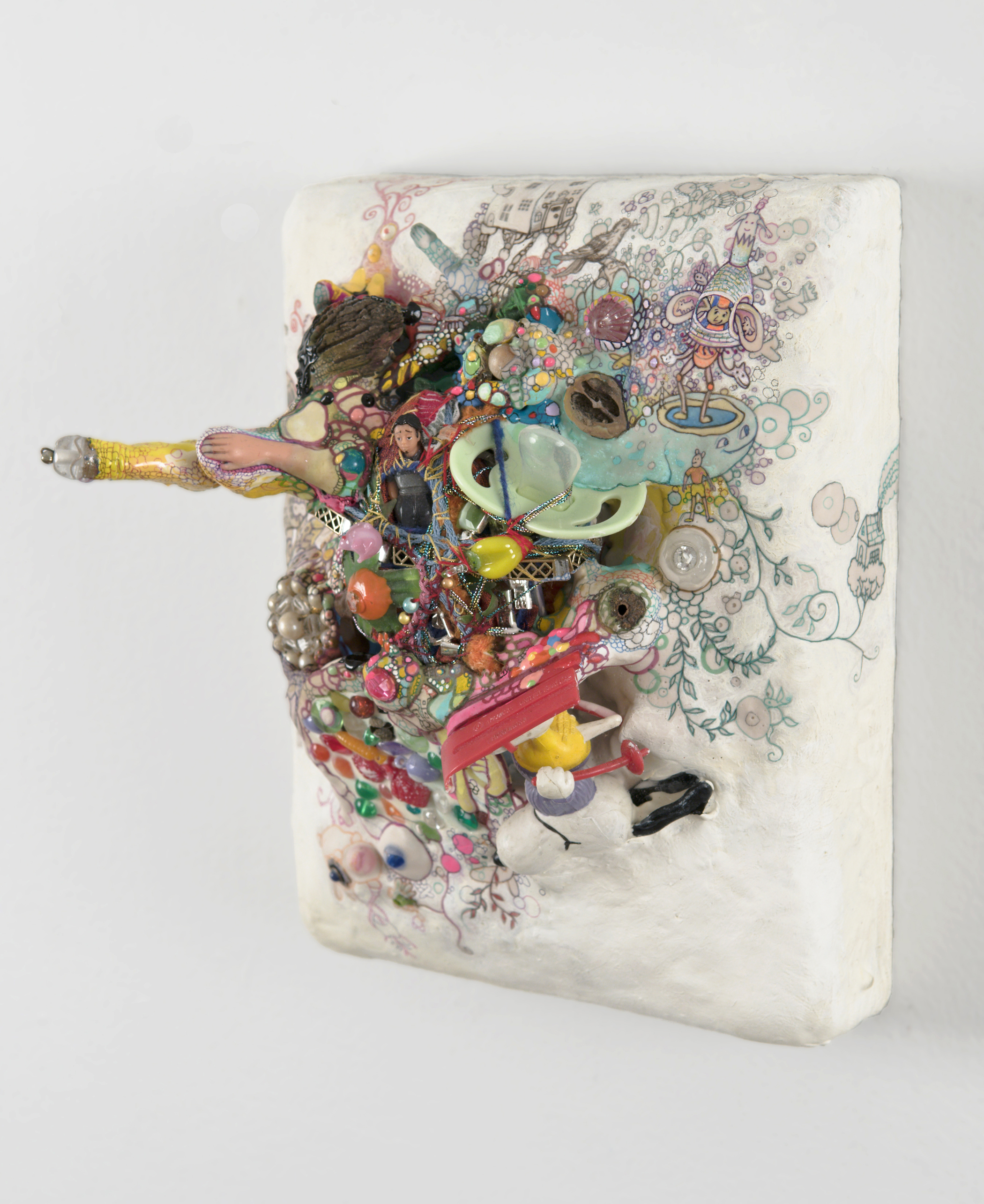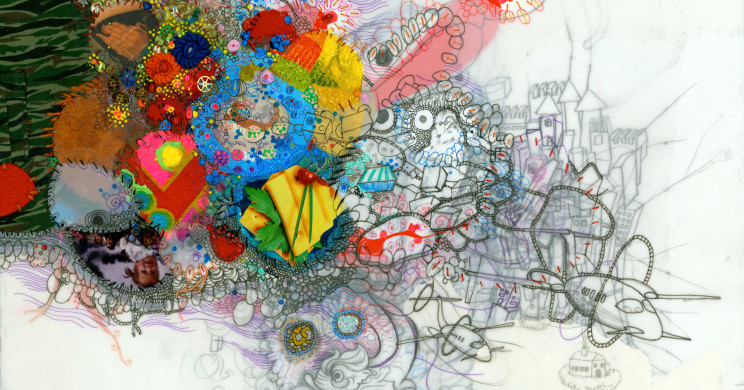Leah Oates: How did you become an artist and what is your family background?
Julie Peppito: When I was in the second grade I drew a picture of a turkey and it won first prize in a statewide elementary school competition in Oklahoma. My mom put me in art classes. In my free time I would draw, sculpt and make jewelry at our dining room table or at a desk in my room. When I was older I became a thrift store and junk shop fanatic. That is when I began to notice the beauty in things others discarded.
LO: What are the ideas in your work and what is your working process?
JP: I wonder why I am drawn to some things and not others. What makes some things valuable and other things trash, or on their way to becoming trash? Sometimes I feel like my purpose is to rescue them. I want to make them have meaning for more time than they are in fashion. I have a love/hate relationship with fashion and consumerism. I have the “I want everything” disease of our culture. I desperately want to buy things, and then I feel incredibly guilty because I know the harm that materialism causes the planet and people. My work is a manifestation of this conflict. It is also a manifestation of my need to connect with others and the world, while at the same time desiring escape and disconnection.
My process begins with collecting. I used to collect only funky Americana statues and nostalgic “collectable-ish” things. Then the lines got fuzzier. Now they are really fuzzy. I collect things that most people would consider trash, along side more notably valuable stuff. Then I mash, bind, and merge them together with wire, clay, cords, fabric, and thread. I paint and draw patterns and images on it. If it is a work on paper there is more imagery. This imagery is narrative, expressing the ideas of connection, disconnection, and value mentioned previously.
LO: Your work uses found materials, drawing and collage and is a unique blend of the whimsical, fantastic, and scary. Please elaborate on how you came to work this way and what this mix represents thematically.
JP: On found materials, collage, whimsical, and fantastical:
When I was very young I used to play in the roots of trees. My dad helped me make little boats out of walnut shells, toothpicks, and paper, and I would pour water in between the elaborate root systems and sail the boats. My dad was an Eagle Scout from Brooklyn turned engineer who had a strong belief in do-it-yourself everything. I was also born in Tulsa, Oklahoma in 1970, at a time when people still made things instead of instantly buying them. It was a place where craft was held in much higher esteem than art (although I hadn’t realized this until I went to Cooper Union for my BFA and learned that what I thought was art was actually considered craft in the NYC fine art world.)
I learned very young that almost anything could be repurposed to make another thing. That led to my thrift/junk obsession. (That obsession was also influenced by my lower middle class budget; plus it was the 80’s and it had recently become fashionable to thrift. Remember “Sixteen Candles”? I was 14 when it came out.)
On Drawing:
I have always loved to draw, and because I was good at it I was always encouraged to do it. I have observed that everyone, regardless of class or culture, can appreciate a good drawing. For a long time I had stopped doing it in rebellion to that realization. Now I draw as an appreciation of that observation, and for my love of the connection to the moment that I feel when I do it.
On Scary:
My mom was a stay-at-home mom from Long island who later got her MSW and became a therapist. She was a feminist baby boomer who took me to march on the capital OKC for the ERA when I was 10 (I think). She had always infused me with a sense of justice even though growing up I was more concerned with boys, fashion, and making things over anything else. After I moved to NYC to go to art school in 1988, I gradually began to learn things about our country and the world that I had never known before. I learned more when I started listening to Democracy Now! on WBAI and reading Howard Zinn’s People’s History of The United States of America. The culmination of all of that was a deep anger for being lied to by the media, history books, and politicians. I believe the “scary” in my work usually comes from this.
What this mix represents thematically:
We are complex creatures. We have all of this amazingly detailed, gross and beautiful stuff on the outsides of our bodies: skin, hair, eyes, pores, butts, appendages, etc… Then there is all of that equally detailed, gross and beautiful stuff on the insides of us. As if that wasn’t enough, there is all of that other stuff that goes on in our brains and our hearts. When you put it all together there is a complete being and each one has a poignant and unique story. I’ve always had an inner drive to make art that is just as complete.

Julie Peppito
Snoopy Homeboy Cake, 2009.
Wood, Found Objects, Epoxy Clay, Aqua Resin, Gouache, Acrylic, Pen, Pencil, Thread.
Variable Dimensions 8 x 10 x 4 in. Image courtesy of the artist
LO: Why do you think art is important to people and what does art do exactly for the world?
JP: I have struggled with this question a lot in my life. I have often felt that being a visual artist is looked upon as selfish and unhelpful. The results are not usually quantifiable like they are with a doctor, lawyer, scientist, teacher, or social worker. I have always had a strong sense of justice and a desire to help and be selfless. What I have realized is that it does help. Art connects us. We spend much of our lives trying not to feel or being cut off from our feelings by the monotony of daily tasks or the horribleness and scary parts of our lives and world events. Art is like love. It makes us feel and it makes it okay to feel. Feeling makes life worth living. So, to pull it all together, art helps make life worth living.
LO: What advice would you give an artist who has just arrived in NYC and who is not sure where to begin?
JP: Network. Show up. Or don’t, and just make art. Or leave, and just make art. Before anything though, come to terms with why you have come here to make art. If you are going to stay and want to make a career out of it realize that you will spend a large amount of your time working a job to support your art while simultaneously running a separate online and in-person networking and PR business. This is all unless you are already well connected and independently wealthy.
There are some contradictions in this amazing city. This is where the critical mass of like-minded people are, but you rarely have time to meet with them (especially if you have procreated). If you do, you can’t make art that takes time to make. There is also a critical mass of people who appreciate art, but it is difficult to figure out where the ones are that will appreciate your particular brand of “making life worth living art” and have the time and money to appreciate it in a way that will sustain you so that you can focus on making their life (and yours!) worth living.
LO: Who are you favorite artists and why?
JP: So many! I like art that insists I look at it for more than a minute. For me this usually means it is well crafted and detailed with visual power. The essential component is that it helps me see the world in a new way. To put it another way, it must make me fall in love with it. When I am making a piece of art I know it is working if I fall in love with it. I want other artists’ work to inspire the same feeling in me. (See previous question “Why do you think art is important and what does art do for the world?)
My list: Niki De Saint Phalle, Mark Ryden, Joyce Scott, Robert Rauschenberg, Sigmar Polke, Vermeer, MC Escher, Swoon, Murakami, Amy Cutler, Gideon Kendall, Paul Klee, Alexander Calder, Dr. Suess, Ernst Haeckel, Banksy, Kim Holleman, Anton Gaudi, Friedensreich Hundertwasser, Norman Rockwell and so many more. Genres: folk, medieval, Baroque, and Renaissance sculpture, painting and jewelry, 19th and early 20th century botanical and animal illustration and decorative objects such as Faberge eggs.
LO: What are your upcoming projects?
JP: For my third show at Heskin Contemporary in the fall of 2013, I am taking personalized commissions. My multi-media collages and sculptures, which incorporate objects from the sitter’s everyday life, are not traditional portraits. This series of work is from my “Connected Portrait Project.” In keeping with my philosophy, each piece explores our complex and varied relationships with objects. Why do we do cherish some items and easily discard others?
To create the portraits, I require ten small objects and/or images. These should be a selection of both commonplace items and items of sentimental value. Three titles of the sitter’s favorite pieces from my website (www.juliepeppito.com) to help inform me about the sitters tastes. And five words from the sitter’s imagination.
I have a longstanding interest in environmental issues and will donate ten percent of the proceeds from the “Connected Portraits Project” to Hurricane Sandy and climate change relief efforts.
If you are interested in participating in the project, please contact me (juliepeppito@gmail.com) for further details and pricing.
























